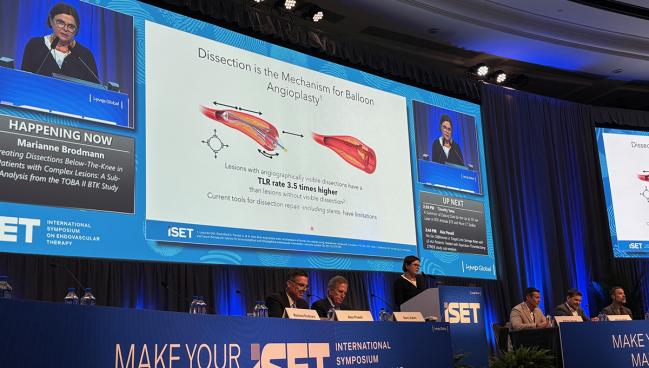Tack Works Well in Dissection Repair of Complex Lesions: TOBA II BTK
CTOs, long lesions, and calcification don’t negatively impact the minimal-metal approach to treatment, a subanalysis suggests.

MIAMI BEACH, FL—Tack repair of dissections works well in complex lesions, whether they’re chronic total occlusions (CTOs), long, or calcified, a subanalysis of the TOBA II BTK study suggests.
Marianne Brodmann, MD (Medical University of Graz, Austria), who shared the late-breaking results yesterday at ISET 2024, said these latest data reinforce the message that Tack works—even for patients with more-challenging characteristics. “In patients with severe BTK disease and complex lesions, dissection repair with Tack resulted in positive outcomes while preserving future treatment options,” she concluded.
Brodmann pointed out that dissection carries consequences for patients. “If we have dissections and leave them behind, the TLR rate is 3.5 times higher than it is without visible dissections,” she said in her presentation.
Tack (Philips) is a long-studied technique in which a minimal-metal nitinol implant is used to repair dissections that arise from standard balloon angioplasty during peripheral interventions. First came the original TOBA study, published in 2016, looking at patients who had a dissection during treatment for femoral-popliteal arterial disease. This was followed by the TOBA II study, TOBA BTK, and then by the current TOBA II BTK, the latter two studies looking at patients with below-the-knee lesions. Finally, there’s TOBA III in patients who develop dissection after drug-coated balloon angioplasty of superficial femoral and proximal popliteal arteries. More than 800 patients have been studied in total.
Fully 169 of the 233 patients enrolled in TOBA II BTK had complex lesions, with some having more than one of these characteristics. These included 111 CTOs, 57 with a lesion length ≥ 115 mm, and 86 with moderate/severe calcification.
Compared with the intention-to-treat population a whole, patients in these subgroups had more severe disease, with 58.6% of those with CTOs, 61.4% of those with long lesions, and 54.7% of those with moderate/severe calcification being in Rutherford class 5. More-severe dissections were seen in the long lesion and CTO groups compared with the broader study cohort.
At 1 year following Tack treatment, 94.1% of the overall group was free from major adverse limb events and perioperative death, as compared with 92.1% of the patients with CTOs, 98.2% of those with long lesions, and 95.5% of those with moderate/severe calcification. Despite the increased complexity, these patients saw no difference in 1-year freedom from major amputation (82.6% with CTO, 84.8% with long lesions, and 83.2% with calcification) compared with the overall population (88.4%). Nor were there differences in 1-year clinically driven TLR or all-cause mortality.
All of the subsets saw equally good improvement in Rutherford classification, as well as in ankle-/tibial-brachial index.
When using Tack “in the arteries, it’s a low amount of metal you deliver and you really [just] use it for sealing dissections, and you have good confidence in leaving as little as possible behind. And it’s doing the job—that’s the point,” Brodmann stressed to TCTMD. “Doing the job means sealing the dissection.”
Unlike in other approaches to dealing with the complication, like scaffolds, “you don’t have to cover the whole vessel area with metal” or potentially raise the risk of in-stent restenosis, she explained. “I think that [Tack] is something that is not having a negative impact on the vessel wall” and doesn’t affect future interventions.
While additional subanalyses will continue to trickle in, for her the current evidence base is sufficiently reassuring. “Yes, it works. . . . I think with the data out there we can use it,” she added.
In 2019, the US Food and Drug Administration cleared Tack for use in above-the-knee dissection. The agency’s approval for below-the-knee use came in 2020. The product also has CE Mark approval in Europe.
Caitlin E. Cox is News Editor of TCTMD and Associate Director, Editorial Content at the Cardiovascular Research Foundation. She produces the…
Read Full BioSources
Brodmann M. Treating dissections below-the-knee in patients with complex lesions: a sub-analysis from the TOBA II BTK study. Presented at: ISET 2024. January 24, 2024. Miami Beach, FL.
Disclosures
- Brodmann reports no relevant conflicts of interest.




Comments